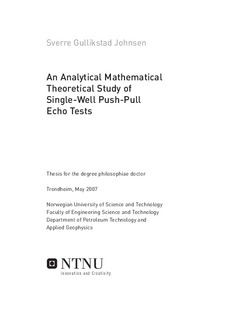| dc.contributor.author | Johnsen, Sverre Gullikstad | nb_NO |
| dc.date.accessioned | 2014-12-19T12:14:05Z | |
| dc.date.available | 2014-12-19T12:14:05Z | |
| dc.date.created | 2007-11-28 | nb_NO |
| dc.date.issued | 2007 | nb_NO |
| dc.identifier | 123055 | nb_NO |
| dc.identifier.isbn | 978-82-471-2680-6 | nb_NO |
| dc.identifier.uri | http://hdl.handle.net/11250/239281 | |
| dc.description.abstract | Analysis of stream-line-based formulations is exercised to develop a stream-line based semi-analytical model for the single-well push-pull test, taking into account natural ground-water drift. The model is employed to calculate the time of breakthrough for clean water and the end-time of tracer production in addition to the overall producing tracer concentration vs. time.
Contradictory to traditional approaches to the problem, natural ground water drift is considered important and physical dispersion of the injectant front is considered negligible.
As a main topic we study injection/production in unconfined homogeneously stratified aquifers of infinite areal extent, subject to natural groundwater drift. Injectant and in situ groundwater are assumed to be miscible, incompressible fluids with identical fluid properties. Only macroscopic flow is considered, and flow is assumed to experience no in situ fluid mixing (physical dispersion) so fluid interfaces remain sharp.
Analytically obtained results are compared to field study data provided by Pickens and Grisak, finite difference numerical simulation data obtained by Coats et al., and stream-line based simulation data from Streamsim Inc.’s 3DSL. The excellent match to experimental data and close agreement with simulation data validate the physical dispersion-free method proposed. It is concluded that the semi-analytical stream-line based solution gives the theoretically true production profile, and that any disagreement with simulation data is due to numerical dispersion and/or a poorly built model, on the simulator side.
Making use of the stream-line based semi-analytical model, it is shown that, for a given set of boundary values and test-parameters, there exists a theoretical maximum injection phase duration giving conservative tracer production. The model is employed to study the tracer production profiles as the injection phase duration is extended to values larger than this limit. The applicability of the onedimensional convection-dispersion equation on calculating apparent dispersivity Peclet numbers is studied, as the injection phase duration is increased, and it is shown how it fails to predict the volume of recoverable tracer and how it fails to fit the measured data. It is also shown how a strongly scale depending apparent dispersivity may occur in a model, with no physical dispersion, due to natural drift only.
Stream-line patterns for a two-well transmission test in a naturally flowing aquifer is created, and studied as a function of natural ground-water drift direction. It has been indicated how the natural ground-water drift may have an even bigger impact on the two-well transmission test than on the single-well push-pull test. | nb_NO |
| dc.language | eng | nb_NO |
| dc.publisher | Fakultet for ingeniørvitenskap og teknologi | nb_NO |
| dc.relation.ispartofseries | Doktoravhandlinger ved NTNU, 1503-8181; 2007:122 | nb_NO |
| dc.title | An Analytical Mathematical Theoretical Study of Single-Well Push-Pull ”Echo” Tests | nb_NO |
| dc.type | Doctoral thesis | nb_NO |
| dc.contributor.department | Norges teknisk-naturvitenskapelige universitet, Fakultet for ingeniørvitenskap og teknologi, Institutt for petroleumsteknologi og anvendt geofysikk | nb_NO |
| dc.description.degree | PhD i petroleumsteknologi og anvendt geofysikk | nb_NO |
| dc.description.degree | PhD in Petroleum Engineering and Applied Geophysics | en_GB |
